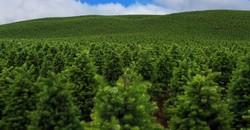Christmas Tree Farm
 A Christmas tree farmer decides to plant pine trees up in hilly property that he owns. Measuring at a constant shortest ground distance from the center, he marks off a circular perimeter that is
meters long. He plants the pine trees at an uniform density of one tree per
square meters. When completed, and after the entire area inside the
meter long circular perimeter is planted with pine trees, he notices that he still has a lot of surplus unplanted pine trees, which means he used less than his original calculated estimates. He then decides to mark off the shortest lines between
points equally spaced along the
meter circular perimeter, and then counts all the trees. He discovers that instead of the expected ratio of
between the tree count inside the
sided boundary and the total tree count inside the
meter circular perimeter, he has the ratio of
. He scratches his head and wonders what's going on.
A Christmas tree farmer decides to plant pine trees up in hilly property that he owns. Measuring at a constant shortest ground distance from the center, he marks off a circular perimeter that is
meters long. He plants the pine trees at an uniform density of one tree per
square meters. When completed, and after the entire area inside the
meter long circular perimeter is planted with pine trees, he notices that he still has a lot of surplus unplanted pine trees, which means he used less than his original calculated estimates. He then decides to mark off the shortest lines between
points equally spaced along the
meter circular perimeter, and then counts all the trees. He discovers that instead of the expected ratio of
between the tree count inside the
sided boundary and the total tree count inside the
meter circular perimeter, he has the ratio of
. He scratches his head and wonders what's going on.
What is the area of the property inside the meter circular perimeter?
If is the area in square meters, find
Note: The Gaussian curvature everywhere on the property inside the meter circular perimeter is , with the allowed exception of a single point. (This means that any patch of the property, which does not include that single point, can be "laid flat", i.e. every point on the surface is locally like a cylinder, where . This is not true for spheres, where , or saddles, where .)
There are no lakes, sinkholes, etc.
Only elementary math is needed to solve this one, no calculus nor differential geometry is needed here.
The answer is 2603.
This section requires Javascript.
You are seeing this because something didn't load right. We suggest you, (a) try
refreshing the page, (b) enabling javascript if it is disabled on your browser and,
finally, (c)
loading the
non-javascript version of this page
. We're sorry about the hassle.
The most critical detail in this problem is the note that the Gaussian curvature everywhere on the property (except a point) is 0 . It means that a flat piece of paper (of any size) can be laid on the property anywhere without gaps or wrinkling. Thus, this problem is similar to that of constructing a cone from a flat sheet. Now, we'll leave it to the imagination why the tree farmer neglected to note that the radius in which he use to mark off the boundary is less than 1 0 0 0 k m , but the graphic given below shows half of the property, laid out flat, including 2 of the sides of the 4 sided boundary, which the tree farmer mistakenly believed would be a square with right angles
Thus, when two of these are joined, this sheet cannot be laid flat any more than a cone can be, but might be expected to in certain hilly country. Now, to meet all the condtions, the following equations must hold
4 r θ = 2 0 0 0 π
2 ( 4 ( 2 1 r 2 S i n ( θ ) ) ) = 2 1 r 2 ( 4 θ ) = A
with the solution being
r = 8 2 8 . 6 9 9
θ = 1 0 8 . 6 0 5 °
A = 2 6 0 3 4 3 3
and thus the answer to this problem is 2 6 0 3
We often think of a cone or a cylinder when rolling up a flat sheet, but this would be more like a doily, which sometimes can have an excess outside perimeter that really cannot be laid flat on the table. Like this figure below